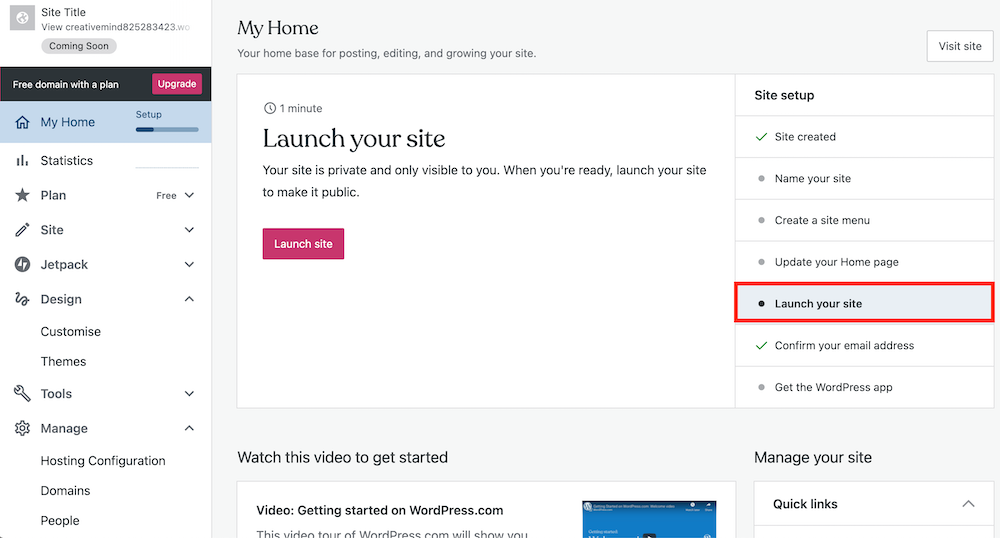Creating a blog on WordPress can be an exciting venture that allows you to effectively share your ideas, knowledge, or promote your business (and it’s free!). Here, we provide a step-by-step guide to help you kickstart your own blog on the platform.
Step-by-Step Guide to Creating a Blog on WordPress:
1.Start
Go to the WordPress page and find the button that says “Get started.” Click to initiate the registration process.

2.Registration
Create your user account. Among the registration options, you can choose email, Apple account, or Google account. Select the one that suits you best and follow the steps indicated on the page.

3.Select Site Type and Domain
Choose “Blog” as the site type, and then the system will prompt you to check the name. In this case, we entered “Test,” and the platform provided a list of domain options. You can see various options, including “WordPress.com” and “.org.” The main difference lies in hosting and control. WordPress.com offers all-in-one hosting, easy to use but with limitations on customization and monetization, especially in the free plan.
In contrast, .org provides the freedom to choose your own hosting, allowing complete customization, access to all themes and plugins, and total control over monetization. If you prefer simplicity and don’t mind some limitations, WordPress.com is a good choice. If you want flexibility, total control, and are willing to handle hosting, WordPress.org is the ideal choice, but keep in mind that you will have to pay monthly for the service. In this example, we will use WordPress.com.

4.Define Goals
Specify your blog goals. Choose from writing, promoting a business or yourself, importing content from another site, sales, or others.

5.Give it a Name
Now, the most important part: the name. It’s advisable to make it the same or similar to what will appear in the subdomain. In this example, we entered “Test.” You can also provide a short description of what visitors can find on your blog.

6.Customize
Now it’s time to fill your blog with content. WordPress will give you three options; in this case, we recommend starting with “Choose a design” to structure your site.

7.Design
Now, determine the design of your blog. You have two options: create your own design or choose from the available templates, both free and paid.

8.Create Content
Once you have chosen your blog’s design, the system will prompt you to write your first entry or post. You can give it a title and fill in the body text. Remember that you can also insert images, videos, and other elements. Explore the options that WordPress offers to unleash your creativity in each post.

9.Publish
Once your entry is ready, you will find the “Publish” option in the upper right corner. Clicking it will make the post visible to everyone who visits the blog.

10.Review
After publishing your entry, you can review it or continue checking the steps to make your blog ready.

11.Blog Launch

WordPress will provide a list of tasks to help you determine if your blog is ready for launch. Verify it, and once you’ve confirmed that you’ve completed each task, click where it says “Publish your site” to make your blog visible to everyone through the link.
12.Create – Publish – Improve

WordPress will notify you that your blog is ready and allow you to view it. From now on, every time you log in to your account, you will have the option to customize anything you desire. It’s also important to clarify that when using the free version, your blog is subject to a subdomain. A domain is the unique address of a website on the internet, like “Test.com.” A subdomain, on the other hand, is an extension of that main domain and precedes the main domain in the URL, for example, “Test.Wordpress.com,” where the word WordPress is the subdomain. Differences Between a Blog and a Website There are some differences between a blog and a website, and knowing them can help you determine if it’s what you’re really looking for.
Essentially, a blog is a specific form of a website characterized by its chronological and regularly updated content. Blog content is usually more informal and personal, with entries following a chronological order and often written in a conversational tone. The blog structure facilitates interaction with the audience through comments and active participation. On the other hand, a website encompasses a broader range of purposes and structures. It can be an online presence for a company, organization, or entity, providing static and structured information.
Websites often have a more complex organization, with multiple pages, navigation menus, and specific sections. Unlike blogs, websites may not be updated as frequently and may have a more general focus in terms of the audience. Although all blogs are websites, not all websites are blogs. The distinction lies in the structure, purpose, and frequency of content updates. So if you’re 100% sure that what you need is a blog, we’re confident that this article will help you start your project 😉



